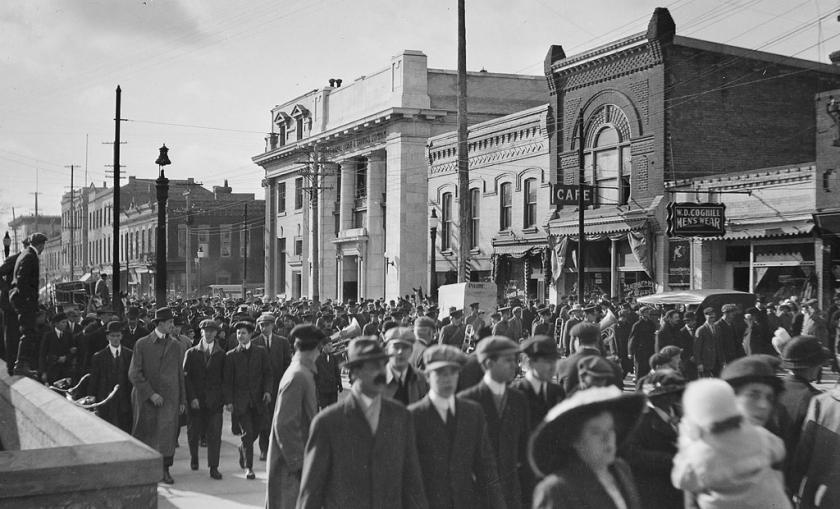Three Communities Respond To War
News that Europe was on the verge of descending into war came as a shock to the people of Brantford, Brant County and Six Nations. Nonetheless, they responded quickly. The reaction of Six Nations was nuanced, reflecting the complexity of the alliance between sovereign nations.
The corner of Queen Street and Dalhousie Street was the place to be as war threatened to break out in Europe in August 1914. Residents eager to get the latest news from Europe gathered outside the home of The Brantford Expositor in the days and evenings leading up to the Declaration of War. “Not since election night has there been such a large crowd around The Expositor building bulletin service boards and the office windows from which the despatches were announced,” The Expositor reported on Aug. 3, 1914.
Back then, The Expositor would put breaking news headlines on bulletin boards in the windows for passersby. The Expositor gathered news from a variety of wire services, some being sporadic and the stories were subsequently published in the daily newspaper.
Shortly, after 8 p.m. on Aug. 4, 1914, the people of Brantford received the BIG news they had been anticipating. A news flash had arrived at The Expositor – England and Germany were at war.

Reaction to the war was swift and enthusiastic. The city was home to many British reservists who had moved to Canada to establish new lives. Following the declaration, they were either on their way or making plans to return to their units.
The Army and Navy Veterans Association held a meeting following the declaration of war and passed a resolution authorizing a letter to be written to the Hon. Sam Hughes, Canadian Minister of the Militia, offering their services.
At the same time, the sergeants of the 25th Brant Dragoons offered their services to Britain. The sentiment in the community was best captured by The Expositor - “Brantford is not going to be left behind other Canadian cities in giving a practical demonstration of its loyalty to the Mother Country in time of strife.”[1]
The city council of the day planned to meet within a day or two of war being declared to come up with some way of supporting the British Reservists and those who volunteered for service overseas.
The Six Nations response to the war continued their tradition of military support for the British Crown. Once Great Britain declared war, the Six Nations Confederacy Council, as the official governing body within the Grand River Territory, declared neutrality, as they had during the American Revolution and during the initial stages of the War of 1812. This did not mean that the Confederacy Council opposed people enlisting. Instead, Six Nations persons had the freedom to enlist as individuals. Although they were not at war, the Confederacy Council still supported the Six Nations men and women who served.
Declaring neutrality was a means of signaling to the British Crown that the Confederacy Council desired a meeting to discuss terms of their alliance. Erosion of First Nations’ rights, especially with the passing of the Indian Act (1876), meant that the Six Nations Confederacy Council thought it best to wait before committing their people to war. As in the past, Six Nations would not go to war for Britain unless they were asked by a representative of the Crown like the King, the Governor General, or a British diplomat.[2]
Once an appeal from a representative was received, the Chiefs of Six Nations would meet with said representative, to determine what assurances would be made to the Six Nations if they participated in the conflict. If suitable terms were reached by the Chiefs, who took care of such civil matters, the final decision to go to war was given to the Clan Mothers. They would make the final declaration of war on Germany and appoint war chiefs to guide Six Nations through the conflict.[3] In this way the civil Chiefs of the Six Nations Confederacy Council could never declare war on their own. If they were to do this, they would be required to hand their titles back to the Clan Mothers for the duration of the conflict. [4]
[1] The Brantford Expositor, August 5, 1914.
[2] The Six Nations were not the only First Nations group in Canada to refuse to support the First World War until they were asked to participate by the British Crown. See Janice Summerby, Native Soldiers, Foreign Battlefields (Ottawa: Veterans Affairs Canada, 2005), 6 and Fred Gaffen, Forgotten Soldiers (Penticton, British Columbia: Theytus Books, 1985), 20.
[3] Lloyd King “114th Regiment in the Great War” (Unpublished speech in the Woodland Cultural Centre’s Warrior Files), 1, Barbra M. Wilson, ed. Ontario and the First World War (Toronto: The Champlain Society, 1977), cxi, and A.A. Goldenweiser “On Iroquois Work 1912” in the Summery Report of the Geological Survey Branch of the Canadian Department of Mines, 1912 (1914), 468.
[4] Tom Porter “Traditions and Customs of the Six Nations” in Pathways to Self Determination, Leroy Littlebear, Menno Bolt, J. Anthony Lang eds. (Toronto: University of Toronto Press, 1984), 21.
